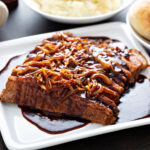Famous Oven Baked Beef Brisket
Servings: 10
Calories: 492kcal
This famous oven baked beef brisket is an adaptation of Nach Waxman's classic family recipe. He is the founder of Manhattan’s Kitchen Arts & Letters. His famous beef brisket recipe has an added step that magically makes the slices firmer and fabulously flavored. With this recipe, you can cook a succulent and juicy beef roast, seasoned to perfection with a remarkable brisket rub. Get ready to savor every bite of this delicious dish!
Print Recipe
Equipment
- Dutch Oven
- Instant Read Themometer
Ingredients
Best Brisket Rub
- 1 tablespoon packed brown sugar
- 1 tablespoon coarse kosher salt
- 1-½ teaspoons smoked paprika
- ¾ teaspoon chili powder
- ½ teaspoon mustard powder
- ½ teaspoon freshly ground black pepper
Brisket
- 6 pound brisket flat, trimmed so that a thin layer of fat remains
- 3 tablespoons vegetable oil
- 2 tablespoons butter
- 8 medium onions peeled and thickly sliced
- 4 garlic cloves peeled and quartered
- 3 tablespoons tomato paste
- 1 carrot peeled and trimmed
Instructions
- Preheat the oven to 375°F.
Best Brisket Dry Rub
- In a small bowl, combine the brown sugar, salt, paprika, chili powder, mustard powder, and black pepper.
Brisket
- Using paper towels, pat the brisket flat dry. Sprinkle the dry rub all over the brisket. Gently pat the rub onto the brisket.
- In a large Dutch oven over medium-high heat, add the oil and heat until shimmering. Add the brisket to the Dutch oven and cook, turning halfway through cooking time, 10 to 14 minutes or until scattered crusty and browned areas appear on the brisket. Transfer the brisket to a platter.
- Add the butter to the Dutch oven and cook until the butter is melted. Add the onions and cook, stirring constantly with a wooden spoon. Continue cooking and scraping up any browned bits from the bottom of the Dutch oven, for 10 to 15 minutes or until the onions have softened and developed a rich brown color. Do not caramelize them. Remove from the heat. Place the brisket on the onions and pour any accumulated juices on the platter over the brisket.
- Using a knife or a small spatula, spread the tomato paste over the brisket. Add the garlic and carrot to the pot. Cover the brisket, transfer it to the oven, and cook, untouched, for 1-½ hours.
- Reduce the oven temperature to 325°F.
- Transfer the brisket to a cutting board. Using a very sharp knife, thinly slice the brisket across the grain into approximately ⅛-inch-thick slices. Return the slices to the pot, overlapping them at an angle so that you can see a bit of the top edge of each slice. If absolutely necessary, add 2 to 3 teaspoons of water to the pot.
- Cover the brisket and cook, occasionally drizzling the meat with pan juices, for about 2 hours, If the pan juices have evaporated, add up to a tablespoon of water and return to the oven.
- When the brisket is fork-tender and and the internal temperature is above 190°F and not over 205°F, remove it from the oven. Lett it stand, covered, for 15 to 30 minutes.
- Arrange the brisket slices on a platter and spoon some of the pan juices over the brisket to barely moisten it.
- Arrange the onions from the Dutch oven around the brisket. Serve warm with your chosen side dishes.
Notes
You can use any large Dutch oven, cast-iron pot, or other ovenproof heavy-bottomed pot or roaster that has a lid. The brisket should fit snugly in the pot
The flat cut of brisket is also called the first cut. If the brisket is already trimmed or if you are trimming it, make sure your cut has a thin layer of fat.
For complete instructions, videos and images on how to trim a brisket, check out this post from the folks at Food Fire Friends.
Nutrition
Calories: 492kcal | Carbohydrates: 12g | Protein: 58g | Fat: 23g | Saturated Fat: 9g | Polyunsaturated Fat: 1g | Monounsaturated Fat: 10g | Trans Fat: 0.1g | Cholesterol: 175mg | Sodium: 980mg | Potassium: 1114mg | Fiber: 2g | Sugar: 6g | Vitamin A: 1357IU | Vitamin C: 8mg | Calcium: 44mg | Iron: 6mg
